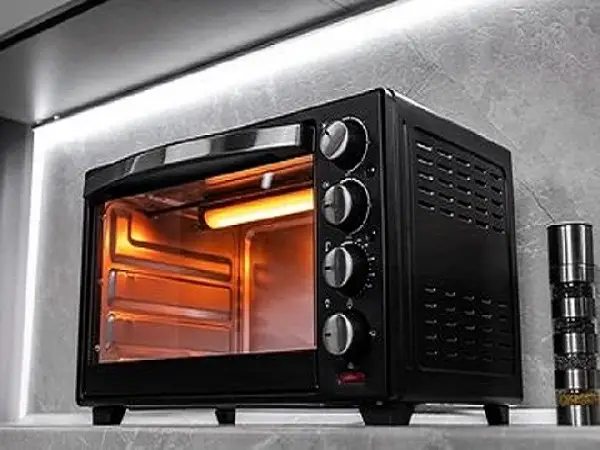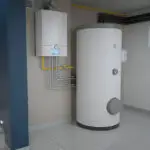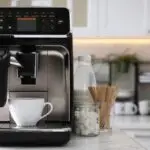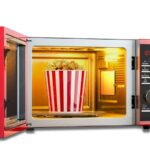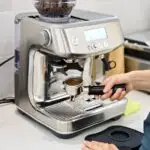An Introduction to Vacuum Ovens
What is a Vacuum Ovens?
A vacuum ovens is an adaptable research laboratory tool that offers a controlled environment for drying, curing, and other heat treatment procedures. Unlike conventional ovens, they work based on reduced atmospheric pressure thus allowing the processing of items at lower temperatures which can prevent oxidation and preserve heat-sensitive substances in a material.
Image | Brand Name | Dscription | Rating | Price | Buy Now |
Ninja DCT402BK | Fry Roast, Fry, Toast, Pizza many More | $260 | |||
Oster | Airfry Oven 12-Function Countertop | $220 | |||
COSORI | 11-in-1 Ceramic Air Fryer | $200 | |||
Ninja DCT451 | 12-in-1 Smart Double Oven | $280 | |||
Nuwave | 100 in 1 Advanced Convection Oven | $250 |
Main Features and Components
Vacuum Chamber:
- This is a sealed chamber where processing takes place and it should be able to bear the vacuum pressure as well as temperature changes.
- Heating System: Ensures even distribution of heat within the chamber by using either shelves that are heated or an outer jacket.
- Vacuum Pump: Required for reducing atmospheric pressure within the chamber to enable low temperature operation.
- Control System: Digital/analogue controls for setting up and monitoring temperature, pressure and time respectively.
- Safety Features: Over-temperature protection, vacuum relief valves, secure door seals
Applications of Vacuum Ovens
- Drying: Removes moisture from samples without thermal degradation occurring quickly & effectively.
- These are commonly used in pharmaceuticals, chemicals, food industries etc.
- Curing and Polymerization: In electronics manufacturing such as adhesives production or composites manufacturing requires materials to cure under controlled conditions using this equipment.
- Degassing: This process gets rid of trapped gasses improving material properties and quality in resin casting or battery manufacture for instance.
- Research and Development (R&D): They best fit lab experiments/sample preparations particularly in areas like material science, biology or chemistry studies among others on that line.
Kinds Of Vacuum Ovens
Standard
These are the vacuum ovens that are most commonly used when it comes to drying and heating in general. They give a good performance at an affordable cost making them fit for many industrial and laboratory purposes.
High-Temperature
These ovens are designed for applications needing higher operating temperatures where they can attain as well as maintain elevated temperatures while still providing a vacuum. Usually, they find their use in engineering and material science fields.
Custom
Whenever there is need for it, custom vacuum ovens can be made to match certain specifications. For example; unique chamber sizes may be required, construction materials should be specialized or control systems might have to be advanced among others.
Advantages of Using
Temperature Control – It allows precision control over temperature reducing risk of overheating delicate materials. Enhanced Drying Efficiency:
- The boiling point of liquids is brought down due to the low-pressure scenario making their drying quickened relatively fast when compared with normal circumstances having high temperatures as per cooling mechanism throughout vacuum ovens in industry operations today thereby enhancing drying efficiency altogether.
- Prevention of Oxidation – Vacuum ovens prevent oxidation and sample contamination by operating in a low oxygen environment.
- Energy Efficiency: Traditional ovens cannot beat most vacuum ones because the latter’s temperature is lower meaning that energy consumption is reduced and therefore it is a bit faster in processing times.
Maintenance and Safety Tips
- Regular Calibration: Periodic calibration of your control system will ensure accurate temperature as well as pressure readings.
- Vacuum Pump Maintenance: Ensure regular oil change, checking the seals etc.
- Cleanliness: For the optimal performance keep the chamber clean.
Safety Protocols:
To avoid accidents and ensure safe usage, follow manufacturer instructions or safety guidelines provided with the equipment one bought.
Different industries and research institutions require vacuum ovens for precise drying, heating, and other applications which are sensitive to high temperatures. Understanding their features, uses, and maintenance ensures efficient functioning of these devices over time.
Operating Principle of Vacuum Ovens
Overview
A vacuum oven functions by creating a low-pressure area within its chamber hence enabling materials to dry, cure or undergo thermal processing at considerably lower temperatures compared to ordinary ovens. This technique is particularly beneficial for materials that are heat-sensitive as well as processes requiring minimal oxidation.
Main Parts and Their Functions
- Vacuum Chamber: The place where material is processed under vacuum. It must be sealed against air leaks & capable of withstanding changing temperatures.
- Heating System: Typically has heated shelves or an outer heating jacket. The system ensures uniform temperature distribution within the chamber.
- Vacuum Pump: Used for lowering pressure inside the chamber by pumping air out among others thus reducing atmospheric pressure here. These pumps include rotary vane pumps (RVP), diaphragm pumps (DP) or turbo molecular pumps depending on required vacuum level.
- Control System: Enables fine tuning and monitoring of temperature, pressure and time of operation. Commonly digitalized, modern systems may include programmable settings for automation.
- Temperature Sensors and Gauges: Monitor air temperature in the chamber ensuring it remains within the set limits.
- Pressure Sensors and Gauges: Keep tabs on vacuum levels within the chamber to ascertain that they are maintained at required limits.
Operating Steps
- Loading the Sample: The material or sample to be processed is placed inside the vacuum chamber on heated shelves or trays.
- Sealing the Chamber: The door of the chamber is firmly closed and sealed so as not to allow air penetration during vacuuming.
- Evacuating the Chamber: Vacuum pump is switched on such that it reduces air and gas (s) from the chamber thus reducing internal pressure. Maintain constant vigilance over vacuum level until it reaches its desired setting point.
- Heating the Sample: Once vacuum has been established, switch on heating system. Reduced pressure lowers boiling point of liquids in a sample thus allowing efficient drying up at lower temperatures, or curing if need be.
- Processing Time: The sample is held at specified temperature and pressure for a certain period before which processing will have been completed. What determines how long this lasts for depends on what material being used are as well as scope purposed by them.
- Cooling and Venting: After processing has ended, turn off the heating system then let the sample cool.Switch off the heating system after processing ends then allow cooling to take place. Finally vent back to atmospheric pressure before opening the door to remove processed material.
Benefits of Vacuum Processing
- Reduced Oxidation – Since there is minimal oxygen present in a low-pressure environment, oxidation process can be prevented leading to preservation of sample quality.
- Lower Boiling Point – Drying could occur at reduced temperature because of lower boiling point in solvents and moisture due to reduction in pressure thus protecting materials which are sensitive towards heat
- Uniform Heat Distribution – Designed in a molding manner, the heating system provides even distribution of heat throughout it thus ensuring consistent processing of materials.
- Energy Efficiency – Compared to conventional ovens, lower operating temperatures and shorter processing times result in reduced energy consumption rates.
Applications of Vacuum Ovens
- Pharmaceuticals: Drying active pharmaceutical ingredients (APIs) and other sensitive compounds.
- Electronics: Curing adhesives and encapsulants in electronic components.
- Food Processing: Drying food products without losing their nutritional value.
- Materials Science: Degassing and drying materials for research and development purposes.
Working Principle of Vacuum Oven
The working principle behind vacuum oven is centered on creation of low-pressure environment that supports efficient and gentle processing of materials. Understanding key parts and steps in carrying out processes can be helpful to optimize vacuum ovens use in various industrial or research applications.
Components of Vacuum Ovens
Vacuum ovens are highly complex pieces of equipment configured to provide controlled low pressure environments for different thermal operations. To use these devices efficiently they need to be understood properly with respect to their constituents.
-
Vacuum Chamber
- Description: The main compartment where the materials are placed for processing.
- Material: Mainly made from stainless steel or other strong substances because they can tolerate high temperatures as well as vacuum pressure
- Function: Creates an air tight surrounding that is needed for maintaining a vacuum condition within a chamber.
-
Heating System
Types:
- Heated Shelves – These have shelves which evenly distribute heat to samples placed on them.
- External Heating Jacket – Bounds the chamber all around then uniformly heats it up also .
Function: Provides uniform heat required for drying, curing or any other purpose while maintaining temperature at a desired level always under control.
-
Vacuum Pump
Types:
- Rotary Vane Pump – Commonly used when reaching medium levels of vacuum will suffice.
- Diaphragm Pump: Used to clean vacuum.
- Turbo Molecular Pump: Achieve ultra-high vacuum.
- Function: Evacuate the chamber and maintain a vacuum by removing air and gases.
-
Control System
Components:
- Digital/Analog Controls: For setting and monitoring temperature, pressure and time.
- Programmable Logic Controller (PLC): for precise control of automation in processes.
- Function: It enables users to fix process parameters as well as monitor how the oven is working.
-
Temperature Sensors and Gauges
Types:
- Thermocouples: Are commonly used when measuring temperatures.
- RTDs (Resistance Temperature Detectors): Provide temperature readings that are quite accurate.
- Function: They measure the temperature within the chamber showing it on display hence maintaining the set values of temperatures inside there at all times possible
6. Pressure Sensors and Gauges
Types:
- Analog Gauges: Easy, straightforward pressure measurement systems
- Digital Gauges: Provide higher accuracy figures that can be read easily too
- Function: Monitors what level of vacuum there is inside to achieve a desired pressure situation within its chamber walls
7. Vacuum Relief Valve
- Description: A safety valve which releases pressure if it exceeds safe limits.
- Function: This prevents an over-pressurization condition thereby defending both the oven and samples from destructions.
8. Door Seal
- Material: Commonly made from highly durable materials such as silicone capable of withstanding high temperatures often reached during use in ovens for vacuum drying or other thermal processes involved in sample preparation procedures among others like glass blowing operations cutting of components assembling punching etcetera some may also be made up special grades resins capable being exposed without getting damaged even after continuous contact at 350ºc under strong alkaline conditions unlike normal epoxy resin based products whose mechanical properties drastically decline within short time periods repeated exposure acidic media general operating ambient temperature upto 200ºc least they may seem do great performances these instances.
- Function: It maintains the vacuum by keeping it airtight.
9. Viewing Window
- Material: Created from extra strong or even seen through material like glass, which are also high rated as far as their ability to withstand the pressure of the vacuum is concerned, hence avoiding breaking of any seal when people want view what inside without opening chamber because they might damage equipments or machinery inside it.
- Function: Instead of breaking the vacuum, this can be used for observing samples that lie within an oven.
10. Vent Valve
- Description: It is a valve that allows air back into the chamber slowly after processing takes place in there.
- Function: This protects ovens and samples from experiencing abrupt changes in pressures due to short duration heating processes such on typical batch items involving annealing treatments prior final machining operations brazing joining techniques together with others like plating painting varnishing etcetera since very large temperature gradients produced during quick cooling cycles may cause thermal shock cracking resulting warpage within delicate assemblies being processed otherwise suffer premature failure before getting soldered finally rest will subjected again next cycle .
Shelves and Trays
- Material: Most vacuum ovens are made of stainless steel or sometimes aluminum, which makes them resistant to rust. This guarantees not to affect any item placed inside regardless of the weight as well as resistance to water.
This involves a reaction between chlorine ions from water and iron, leading to rusting accompanied by corrosion which further causes pitting and damage. Energy is wasted, maintenance costs shoot up and structural integrity declines ultimately resulting in accidents and injuries.
Proper management, quality control measures as well as safety precautions such as personal protective equipment (PPE) and regular inspections are important in preventing accidents and maintaining a safe work environment.
- Function: They are responsible for both holding up samples and allowing even distribution of heat throughout the process.
Features:
- Efficient degassing of materials by having strong vacuum pumps
- Could be used with accessories like vacuum chambers and rotary pumps.
- Resin casting, polymer processing, and production of high purity materials among others.
Explosion-Proof Vacuum Ovens
- Description: Designed for safe handling of explosive or volatile substances.
- Features: Made of components resistant to explosion and have safety features.
- They include safety interlocks and controlled venting systems.
- Applications: Chemical processing including hazardous material testing, petrochemical industries etc.
Large Capacity Vacuum Ovens
- Designed for large batches or oversized samples in mind.
Features:
- Increased volume internally
- Advanced heating and vacuum systems to cope with the heavier load
- Applications: Industrial scale drying, curing processes, heat treatment etc..
Laboratory Vacuum Ovens
- Small to medium ovens suitable for laboratory purposes as a rule.
- Characteristics: Tiny design equipped with exact control devices…
- Meaningful in terms of research work or low-level manufacturing activities,
- Applications: Academic research involving small-scale manufacturing and quality control tests.
Specialized vacuum ovens for culinary uses do exist.
Choice of the appropriate type of vacuum oven is critical to successful outcomes across various applications. Each type has been designed to meet particular needs whether it’s drying, curing, degassing or processing volatile material.
It therefore becomes important that you understand the features as well as the applications relating to each kind so that you can pick out the best-suited vacuum oven that will cater for your needs accordingly.
Applications of Vacuum Ovens
Vacuum ovens are some versatile tools employed in numerous sectors including scientific research because they allow temperature and pressure conditions to be controlled. Below are some significant uses of these machines:
-
Drying and Dehydration
- Pharmaceuticals – For drying heat-sensitive compounds without oxidation.
- Food Industry – For dehydrating food products without affecting their nutritional value and flavor.
- Biological Samples – Drying biological specimens without damaging delicate structures.
-
Heat Treatment and Annealing
- Metallurgy: For annealing metals to eliminate internal stresses thus improving ductility.
- Polymer Science: Curing polymers and resins for desired mechanical properties.
-
Moisture Removal
- Electronics: To avoid corrosion as well as ensure reliability, the electronic components should be moisture-free.
- Manufacturing: Before further processing and packaging, some manufacturing processes require moisture removal from materials.
-
Degassing and Outgassing
- Material Science – There will be no more gases trapped in ceramics or composites with this technique.
- Aerospace – So that there is no contamination of the space equipment, it is necessary to degas any of its parts.
-
Chemical Reactions and Synthesis
- Organic Chemistry – This refers to conducting reactions at reduced pressure in order to shift equilibria or lower reaction temperatures.
- Nanotechnology – This involves synthesis of nanostructured materials e.g nanoparticles.
-
Purification and Distillation
- Pharmaceuticals – Solvents in which drugs are dissolved are removed through distillation at low temperatures so as to purify drugs.
- Chemical Industry – Volatile impurities can be removed by distilling chemical substances used in the industry.
-
Storage and Preservation
- Museum & Archival Work: These works entail preservation of historical documents besides artifacts through their storage in controlled environments devoid of degradation.
- Research Laboratories — To avoid contamination or degradation, sensitive materials must be stored under vacuum conditions.
8. Testing & Quality Control
- Material Testing- Evaluating Materials Thermal Properties And Stability
- Component Testing–Testing how components behave under vacuum particularly for aerospace & electronics industries,
9. Evaporation & Concentration
- Pharmaceuticals- Evaporating solvents in order to concentrate active substances
- Food Industry- Involves removing excess moisture by concentrating flavors and extracts.
10.Specialized Applications
- Medical Devices – The sterilization of medical instruments is done without using high heat that may impair their functioning.
- Environmental Science – For research or testing purposes, it may be necessary to create vacuum conditions similar to those experienced in outer space.
- Industrial — Curing composites, drying pharmaceuticals, and processing electronics
- Laboratory: Sample preparation, solvent recovery, thermal treatments,
- Culinary—Drying food ingredients, and innovative cooking techniques.
Benefits of Vacuum Ovens
Vacuum ovens are advantageous in different areas of industry and scientific research due to their distinct operational characteristics.
The following are some of the advantages of using vacuum ovens:
- Controlled Environment: Use of vacuum ovens allows for controlling temperature and pressure conditions in a chamber. Such control is important for such processes as drying heat-sensitive materials or conducting reactions under reduced pressure which all require specific atmospheric conditions.
- Prevention of Oxidation: Vacuum ovens eliminate oxygen and moisture levels inside the chamber, preventing oxidation and degradation of sensitive materials like pharmaceuticals, foods or electronic components. This guarantees long storage life span as well as maintenance of product quality.
- Uniform Heating: No air exists within the chamber leading to uniform heating that takes place on any material being heated. Therefore, there will be a common tendency to carry out consistent drying or heat treatment throughout the sample reducing chances where uneven results can occur or damage to material.
- Gentle Processing: Delicate substances that cannot withstand high temperatures or oxidative environments can be gently processed via vacuum ovens. It is therefore important in industries like pharmaceuticals and biotechnology where preserving compounds’ integrity and biological samples is critical.
- Moisture Removal: When compared with traditional drying methods, efficient moisture removal at lower temperatures helps maintain structural and functional properties. Especially in food processing where maintaining nutritional values and flavors is important.
- Versatility: Drying, annealing, degassing, distillation, heat treatment are among various applications suited by vacuum ovens which are versatile instruments. They can accommodate different sizes and types of samples making them suitable for small scale laboratory studies as well as industrial production.
- Energy Efficiency: Working on a low temperature due to reduced pressure could contribute to energy reduction unlike other conventional techniques like oven usage or higher temperature based drying procedures which need high temperature.
- Safety: The fact that volatile substances have been removed by vacuum ovens minimizes risk associated with hazardous reactions and explosions besides maintaining controlled conditions within the chamber. This ensures safety of employees at work and prevents chemicals from pollution.
- Quality Assurance: Precise control and uniformity provided by vacuum ovens is responsible for product quality consistency in manufacturing process as well as reproducibility in research experiments. Such is crucial to meet regulatory standards and assure dependability.
- Long-term Storage: Vacuum ovens are also used for long-term storage of sensitive materials such as archival documents, artifacts, and research samples. It assists in reducing deterioration thus preserving the integrity of items stored over long periods.
To sum up, vacuum ovens have become integral parts of various industries as well as scientific pursuits due to their role in improving process efficiency, product quality, and safety thereby making them indispensable controlled thermal processing and preservation tools
Maintenance and Safety Considerations
There are certain things that one has to take into account while maintaining or operating a vacuum oven so as to ensure that they are running smoothly, safely and for longer durations. The following are maintenance and safety considerations that ought to be noted with respect to vacuum ovens:
Maintenance Considerations
- Periodic Cleaning: On a regular basis, clean the inside of the oven body so that no residues and pollutants can disturb the uniformity of heating or be transported into samples.
- Seal Check: From time to time inspect oven door seals. Always exchange old or damaged seals in order to sustain vacuum tightness and prevent leakages.
- Vacuum Pump Maintenance: In case of an oven with a vacuum pump, follow the manufacturer’s recommendations concerning its maintenance such as oiling, filter replacement and suction level checks.
- Calibration: It is important to calibrate temperature and vacuum gauges on regular basis for accurate readings. The frequency of calibration may vary depending upon usage and industry standard.
- Element Inspection: There is a need to check elements that heat for signs of wearing or damage. When this happens, replace them immediately as they determine how heating will take place.
- Ventilation & Air Flow: Ensure there is enough ventilation around the oven even when it heats up during use to avoid overheating and allow proper air movement.
- Safety Checks: On a routine basis, carry out safety checks on electrical items such as switches and controls so that any anomaly or hazard is detected in good time before it escalates.
- Records Keeping: Records should be maintained showing maintenance activities conducted on ovens plus those associated with calibrations or repairs made since these keep track of performance history towards conformity with statutory requirements.
Safety Considerations
- Ventilation : Run the oven in a well-ventilated atmosphere because some fumes/gas may be discharged during processing
- Electric Safety : Ensure your oven is properly grounded and electrical connections are secure by following safe practices for handling electrical components without overloading circuits
- Temperature Regulation : For preventing overheating as well as fire hazards, ensure monitoring along with controlling temperatures within recommended limits
- Vacuum Operation : Observe procedures while establishing/ breaking vacuum conditions safely to avoid sudden pressure fluctuations capable of damaging an oven or risking human life
- Emergency Procedures: Establish emergency shutdown procedures and make sure that all users are trained on what to do in case of equipment failure, leak or other emergencies
- PPE (Personal Protection Equipment): Use gloves, goggles among others when handling samples and during maintenance operations to avoid burns, chemical exposure, and mechanical hazards.
- Training : Training should be provided to all personnel using the vacuum oven on how it should be used safely plus its maintenance requirements.
- Regulatory Compliance: Ensure compliance with applicable safety standards such as electrical safety codes and those related to vacuum equipment in your industry/jurisdiction.
By adhering to these maintenance and safety concerns, users can maximize the potential of their vacuum ovens, prolong their life cycle while also providing a safer working atmosphere for laboratory staff as well as industrial workers at large.
Future Trends and Innovations
Future trends:
As we consider ahead several future trends and innovations shaping vacuum ovens’ future enhancing their capabilities and broadening their applicability across varied industries. Here are some future key trends:
- Enhanced Automation & Integration: Smart Controls: Integrating advanced sensors and Internet of Things (IoT) technologies for real time monitoring & control of temperature, pressure, process parameters.
- Automated Processes: Use automated systems to load/unload samples; vary parameters; schedule operations. This way efficiency will be enhanced while manual labor is reduced.
- Improved Performance & Efficiency: Improved Heating Technology: Develop energy efficient heating elements and insulation materials that lower power consumption while ensuring uniformity in temperature distribution. High Vacuum Capability: Increase ability to reach higher levels of vacuum by advancing the technology used for making vacuum pumps along with seals.
Multi-functional Capabilities
- Many-Purpose Processes: Design vacuum ovens with several chambers or configurations that can accommodate more than one function at the same time, e.g., drying, annealing and sterilizing.
- Combined Technologies: Enhancing drying efficiency and meeting specific processing aims through integration with companion technologies like microwave heating or ultrasonic processing.
Material Innovation and Compatibility:
- Advanced Materials: Use specialized materials that do not corrode, withstand high temperature and vacuum conditions to broaden the range of safe and efficient materials which can be processed.
- Compatibility with New Materials: Modifying the system for handling new materials used in emerging industries such as nanotechnology, advanced ceramics and biotechnology.
Environmental and Safety Standards:
- Eco-friendly Design: Develop vacuum ovens that are environmentally friendly which include using eco-friendly refrigerants as well as materials.
- Enhanced Safety Features: Incorporate state-of-the-art safety measures including automatic shutdown systems, gas detection sensors, emergency ventilation controls for ensuring user safety and compliance with regulations.
Application-specific Innovations:
- Customizable Solutions: Provide customizable features and configurations to meet specific needs of industries such as pharmaceuticals, electronics, aerospace or food processing among others.
- Innovative Applications: Envisioning novel applications in areas related to 3D printing post-processing; advanced material research; space technology where exact vacuum conditions are crucially important.
Data Analytics and Connectivity:
- Data-driven Insights: Utilization of tools for data analytics to process information on problems occurring during a working cycle allowing for optimization of performance levels and anticipating tasks requiring maintenance before they break down while maintaining process control standards
- Connectivity – Integration into cloud based platforms for remote monitoring, data storage/analysis enabling real-time collaboration & troubleshooting
- User Experience and Ergonomics:
- User-friendly Interfaces – Design intuitive interfaces that are easy to use software packages making it possible to operate them without much training hence increasing productivity levels
- Ergonomic Design – Improving ergonomics mainly for easy servicing, handling samples and overall user comfort when running the machine
Global Standards and Compliance:
- International Harmonization: Calibration with global standards and regulations in order to ease market acceptance and ensure interoperability across different regions/industries.
Collaborative Research and Development:
- Industry-Academia Partnerships: By partnering with industrial leaders, research institutions, and universities the whole process helps in promoting innovation; exploration of new applications as well as advancing vacuum oven technology.
With these trends and innovations in mind, vacuum ovens are expected to continue playing an ever-increasingly important role in scientific research advancement, industrial manufacturing revolution as well as technological development with enhanced performance, efficiency and safety for countless applications moving forward.
FAQs
How does a vacuum oven work?
A vacuum oven functions by removing air or moisture from its chamber using a pump (vacuum), thus creating low pressure conditions inside the oven. This is followed by heating the material kept inside it that allows effective drying or processing without any risk of oxidation or thermal degradation.
What are the typical applications of vacuum ovens?
- Vacuum ovens find applications across multiple industries as well as research areas including;
- Moisture removal from electronics, pharmaceuticals among others that are heat sensitive.
- Annealing metals/polymer to enhance their properties
- Dehydrating materials with volatile substances & moisture content
- Running chemical reactions at low pressures
- Preservation of fragile biological samples & archival items.
What are the advantages of using a vacuum oven?
- Benefits include how such equipment constitutes:
- Controlled environment where precise temperature/pressure control could be achieved,
- Prevention of oxidation along with thermal degradation,
- Even heating throughout all parts of the work piece,
- Mild treatment of delicate substances,
- Adaptability for many fields within different sectors.
How do you maintain a vacuum oven?
- Regular cleaning out of the chamber to remove contaminants.
- Inspection and replacement of door seals and gaskets.
Are vacuum ovens appropriate for R & D?
Yes, they are commonly used in research and development to study new materials, perform experiments under controlled conditions, and develop new methods. They give scientists a place that is free from outside atmospheric distractions where they can study material properties, chemical reactions and thermal behavior.
What are some emerging applications of a vacuum oven?
- Below are the emerging applications of vacuum ovens:
- Advanced materials research like nanotechnology and graphene production
- Energy storage devices such as lithium-ion batteries and supercapacitors
- Aerospace and space technology for creating vacuum compatible components
- 3D printing post-processing aimed at enhancing material qualities and reducing flaws
How do vacuum ovens promote quality control in manufacturing?
Vacuum ovens contribute to quality control by guaranteeing consistent manufacturing conditions which are vital for all industrial sectors. Control of parameters such as moisture content, material stability, surface characteristics ensures product quality performance and reliability.
Can one use vacuum ovens in cleanroom environments?
Yes, provided they are designed accordingly while observing precautions to prevent contamination with suitable measures in place; it will be possible to have a cleanroom-compatible vacuum oven model that has sealed chambers with smooth surfaces that can be easily cleaned using HEPA filters as required by the strictest standards of cleanliness.
How do vacuum ovens support sustainable manufacturing practices?
They help minimize energy consumption through efficient heating techniques during the processing stage; optimize resource utilization by minimizing waste generation; facilitate process efficiency improvements; allow for use of environmental friendly raw materials where applicable during manufacturing among other merits.
Pros and Cons of Vacuum Ovens
Advantages:
Consistent Heating:
- This is important because it ensures uniform distribution of heat throughout the process which is very crucial when dealing with delicate processes.
- High-precision instruments prevent hot spots from forming, thus protecting sensitive materials.
Lower Drying Temperatures:
- By using low drying temperature, there is reduced risk of degradation of heat sensitive materials.
- These are suitable for drying materials that decompose or oxidize at high temperatures.
Faster Drying Times:
- In most cases, it helps to hasten the removal of moisture and solvents thereby enhancing efficiency.
- Vacuum conditions lower the boiling point, making liquids evaporate quickly.
Controlled Atmosphere:
- This prevents oxidation or contamination by inert gases which are introduced into the chamber.
- It provides a clean and stable environment for delicate procedures.
High Purity Results:
- They also minimize contamination from external sources hence leading to more pure dried products obtained.
- For instance, these are used in pharmaceutical, food industries as well as chemical companies that need pure substances only.
Multiple Purposes:
- They can be applied in various purposes such as drying, curing and annealing among others.
- Besides, they suit different types of materials including metals, polymers and organic chemicals.
Disadvantages:
High Initial Cost:
- Generally, costs associated with purchasing them are higher than those paid for common ovens.
- The latest technology has led to advanced features thus raising initial prices above average
Maintenance Requirements:
- For continued vacuum integrity and optimum performance regular maintenance is necessary
- A good example is that many parts like vacuum pumps require frequently being inspected or changed
Limited Capacity:
- Compared to traditional ovens, vacuum ovens are generally smaller in size
- As a result, this makes it hard for them to be effectively used for large scale processing or production purposes for bulk material handling depending on requirements too
Complex Operation:
It has been found out through researches carried out on them that they require someone who is skilled enough to handle their operation as well their maintenance after buying one of them.
In conclusion
Scientific research, industrial manufacturing, and other specific applications all heavily rely on vacuum ovens; due to their magnificent temperature and atmospheric control mechanism. This has found great use in those processes that either demand gentle heat treatment of sensitive matters or filling the samples with oxygen while maintaining their integrity.
Vacuum ovens are used in the pharmaceutical industry, electronics manufacture, food processing units, and material science laboratories because they enable drying, sterilization, annealing as well as other critical operations under controlled vacuum conditions. The importance of modern manufacturing and research to enhance process efficiency, maintain product quality and ensure safety is thus underscored by its ability to perform these functions.
We can also state that a focus on automation advancements, incorporation of emerging technologies and adoption of sustainable approaches towards designing will serve to improve functionality of vacuum ovens thereby making them more friendly to the environment. As vacuum ovens continue changing through time they will likely become increasingly relevant for aiding scientific discoveries, optimizing industrial procedures and meeting various global market requirements.

